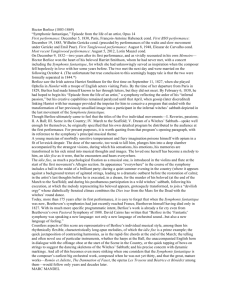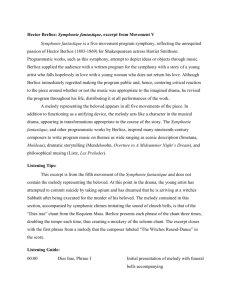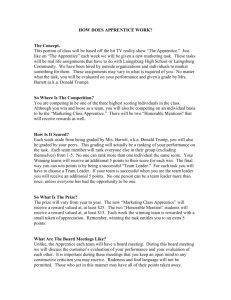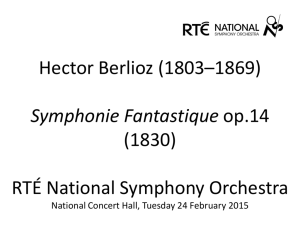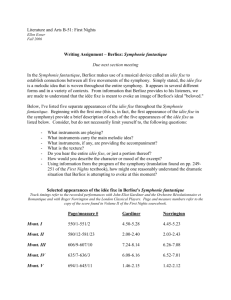Symphonie Fantastique - Knoxville Symphony Orchestra
advertisement
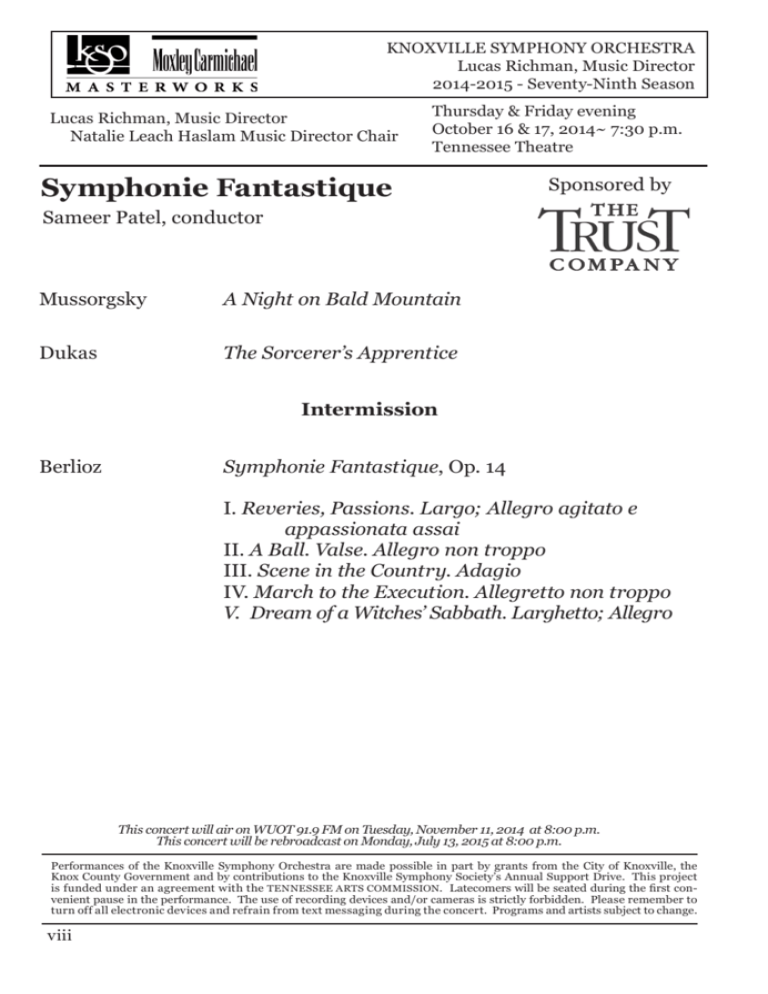
KNOXVILLE SYMPHONY ORCHESTRA Lucas Richman, Music Director 2014-2015 - Seventy-Ninth Season Lucas Richman, Music Director Natalie Leach Haslam Music Director Chair Thursday & Friday evening October 16 & 17, 2014~ 7:30 p.m. Tennessee Theatre Symphonie Fantastique Sponsored by Sameer Patel, conductor Mussorgsky A Night on Bald Mountain DukasThe Sorcerer’s Apprentice Intermission BerliozSymphonie Fantastique, Op. 14 I. Reveries, Passions. Largo; Allegro agitato e appassionata assai II. A Ball. Valse. Allegro non troppo III. Scene in the Country. Adagio IV. March to the Execution. Allegretto non troppo V. Dream of a Witches’ Sabbath. Larghetto; Allegro This concert will air on WUOT 91.9 FM on Tuesday, November 11, 2014 at 8:00 p.m. This concert will be rebroadcast on Monday, July 13, 2015 at 8:00 p.m. Performances of the Knoxville Symphony Orchestra are made possible in part by grants from the City of Knoxville, the Knox County Government and by contributions to the Knoxville Symphony Society’s Annual Support Drive. This project is funded under an agreement with the TENNESSEE ARTS COMMISSION. Latecomers will be seated during the first convenient pause in the performance. The use of recording devices and/or cameras is strictly forbidden. Please remember to turn off all electronic devices and refrain from text messaging during the concert. Programs and artists subject to change. viii Program Notes: Symphonie Fantastique Notes on the Program by Ken Meltzer A Night on Bald Mountain (orch. Nikolai Rimsky-Korsakov) (1867) Modest Mussorgsky was born in Karevo, Russia, on March 21, 1839, and died in St. Petersburg, Russia, on March 28, 1881. Instrumentation: The Nikolai RimskyKorsakov orchestration of A Night on Bald Mountain is scored for piccolo, two flutes, two oboes, two clarinets, two bassoons, four horns, two trumpets, three trombones, tuba, timpani, harp, bass drum, cymbals, orchestra bells, tam-tam and strings. Duration: 12 minutes According to Russian legend, a Witches’ Sabbath occurs each year on June 23, St. John’s Night—the night before the feast of St. John the Baptist. Satan presides over the demonic celebration on Mount Triglav— also known as “Bald Mountain” or “Bare Mountain”—located near Kiev. Russian composer Modest Mussorgsky completed his orchestral work, A Night on Bald Mountain, in June of 1867. Mussorgsky explained his program for the work: So far as my memory doesn’t deceive me, the witches used to gather on this mountain, gossip, play tricks and await their chief—Satan. On his arrival they, i.e., the witches, formed a circle around the throne on which he sat, in the form of a kid, and sang his praise. When Satan was worked up into sufficient passion by the witches’ praises, he gave the command for the sabbath, in which he chose for himself the witches who caught his fancy.—So this is what I’ve done. At the head of my score I’ve put its content: 1. Assembly of the witches, their talk and gossip; 2. Satan’s journey; 3. Obscene praise of Satan (annotator’s note: In the score, this section is actually entitled “Black service”); and 4. Sabbath. If the work is performed, I wish this program to appear on the bills for the enlightenment of the audience. At the height of the Sabbath, a distant church bell sounds. The spirits disappear, and A Night on Bald Mountain concludes with the arrival of dawn, and the return of peace. § The Sorcerer’s Apprentice (1897) Paul Dukas was born in Paris, France, on October 1, 1865, and died there on May 17, 1935. The first performance of The Sorcerer’s Apprentice took place in Paris, as part of a concert by the Société Nationale, on May 18, 1897. Instrumentation: The Sorcerer’s Apprentice is scored for piccolo, two flutes, two oboes, two clarinets, bass clarinet, three bassoons, contrabassoon, four horns, two trumpets, two cornets, three trombones, timpani, orchestra bells, suspended cymbals, triangle, cymbals, bass drum, harp and strings. Duration: 12 minutes The Sorcerer’s Apprentice is not only the best-known work of French composer, Paul Dukas; it remains one of the most familiar of all concert pieces. The Sorcerer’s Apprentice, an instant success at its 1897 premiere, continued to enjoy tremendous popularity for the next several decades. Then, in 1940, The Sorcerer’s Apprentice was immortalized on the silver screen, courtesy of the Walt Disney animated classic, Fantasia. In the film, Mickey Mouse portrays the hapless apprentice, whose misadventures are set to Dukas’s brilliant score, performed by Leopold Stokowski and the Philadelphia Orchestra. The great German poet, Johann Wolfgang von Goethe (1749-1832), provided the inspiration for Dukas’s magical orchestral scherzo. In a ballad, entitled Die Zauberlehrling, Goethe tells the story of a magician’s apprentice. The apprentice has observed his master’s ability to bring a broomstick to life in order to do the sorcerer’s bidding. The apprentice has divined the sorcerer’s magical incantation. And so, when the sorcerer departs, the apprentice animates the broomstick and orders it to fetch water. The broomstick complies, but much too enthusiastically—soon, the magician’s house is overflowing with water! The apprentice tries to stop the disaster by chopping the broom in half with an axe, but that causes two brooms to emerge and further inundate the house with water. Finally, the sorcerer returns, and with a wave of his hand, restores calm. All of the action of Goethe’s poem is masterfully portrayed in Dukas’s scintillating music. § Symphonie fantastique, Opus 14 (1830) Hector Berlioz was born in La Côte-SaintAndré, Isère, France, on December 11, 1803 and died in Paris, France, on March 8, 1869. The first performance of the Symphonie fantastique took place at the Paris Conservatoire on December 5, 1830, with François-Antoine Habeneck conducting the Orchestra of the Société des Concerts du Conservatoire. ix Program Notes: Symphonie Fantastique Instrumentation: The Symphonie fantastique is scored for piccolo, two flutes, two oboes, English horn, E-flat clarinet, two clarinets, four bassoons, four horns, two trumpets, two cornets, three trombones, two tubas, timpani (two players), bass drum, cymbals, suspended cymbals, snare drum, low bells (offstage), two harps and strings. Duration: 49 minutes In September 1827, Hector Berlioz, then a 23-year-old student at the Paris Conservatory, attended productions by an English touring company of Shakespeare’s Hamlet and Romeo and Juliet. In those performances, Harriet Smithson portrayed the tragic heroines, Ophelia and Juliet. Berlioz immediately fell in love with the young and beautiful Irish actress. Berlioz did everything within his power to have Smithson take notice of him, but without success. In February of 1830, Berlioz wrote to his sister, “I am about to commence my grand symphony (Episode in the Life of An Artist), in which the development of my infernal passion will be depicted.” On April 16 of that same year, Berlioz announced that his Symphony was complete. The premiere of the Symphonie fantastique took place at the Paris Conservatory on December 5, 1830, with François-Antoine Habeneck conducting the Orchestra of the Société des Concerts du Conservatoire. The drama, innovation, and sheer audacity of the young composer’s vision stunned the audience. Eventually, Berlioz and Smithson wed, but the marriage proved to be an unhappy one, ending in divorce. Berlioz, a gifted and prolific writer, provided the following program notes for his Symphonie fantastique. A young musician of morbidly sensitive temperament and lively imagination poisons himself with opium in an attack of lovesick despair. The dose of the narcotic, too weak to kill him, plunges him into a deep slumber accompanied by the strangest visions, during which his feelings, his emotions, his memories are transformed in his sick mind into musical images. The Beloved herself becomes for him a melody, a cyclical theme (idée fixe) that he encounters and hears everywhere. (Annotator’s note: The idée fixe is introduced approximately five minutes into the opening movement by the flute and first violins.) x I. Reveries, Passions (Largo; Allegro agitato e appassionato assai)—At first he recalls that sickness of the soul, those intimations of passion, the apparently groundless depression and intoxication he experienced before he met the woman he adores; then the volcanic love that she inspired in him, his delirious anguish, his furious jealousy, his return to tenderness, his religious consolation. II. A Ball (Valse. Allegro non troppo)—He meets his beloved again in the midst of the tumult of a glittering fête. III. Scene in the Country (Adagio)— On a summer evening in the country, he hears two shepherds piping back and forth a ranz des vaches (the traditional melody of Swiss shepherds for summoning their flocks); this pastoral duet, the peaceful landscape, the rustling of the trees gently rocked by the wind, some prospects of hope he recently found—all combine to soothe his heart with unusual tranquility and brighten his thoughts. But she reappears, he feels his heart tighten, he is smitten with sad foreboding: what if she were to prove false?…One of the shepherds resumes his simple tune; the other no longer responds. The sun sets…distant roll of thunder… solitude…silence. IV. March to the Execution (Allegretto non troppo)—He dreams he has murdered his Beloved, that he has been condemned to death and is being led to the scaffold. The procession advances to the sound of a march that is now somber and agitated, now brilliant and solemn, in which the muffled sound of heavy steps is suddenly juxtaposed with the noisiest clamor. At the end, the idée fixe returns for a moment like a final thought of love, suddenly interrupted by the death blow. V. Dream of a Witches’ Sabbath (Larghetto; Allegro)—He imagines himself at a Witches’ Sabbath, among a hideous throng of ghouls, sorcerers and monsters of every kind, assembled for his funeral. Ominous sounds, groans, bursts of laughter, distant cries that other cries seem to answer. The Beloved’s melody reappears, but it has lost its noble and timid character; it has become a vulgar dance tune, unworthy, trite and grotesque: there she is, coming to join the Sabbath…A roar of joy greets her arrival…She takes part in the infernal orgy…The funeral knell, a burlesque parody of the Dies irae…the witches’ round…the dance and the Dies irae are heard together.
